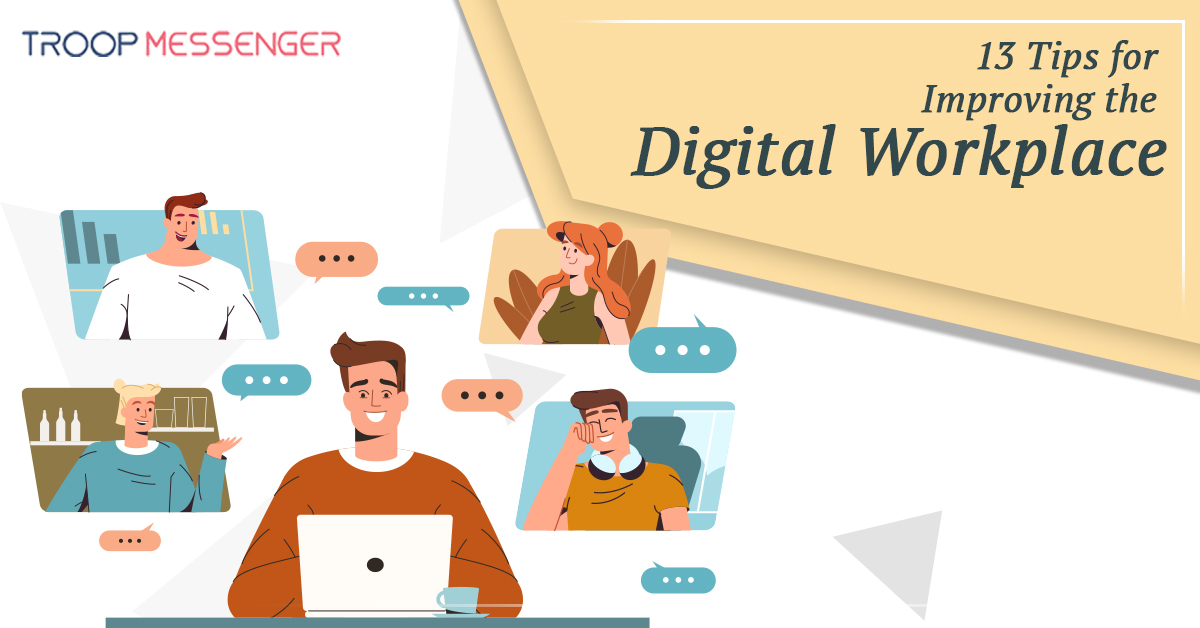Connect with us

12 Tips for Improving the Digital Workplace
The way we work is changing. The COVID-19 pandemic has forced companies to rapidly adapt to a new reality where remote and hybrid work is the norm, not the exception.
This new way of working presents both challenges and opportunities for businesses. On the one hand, they need to be able to support their employees in this new environment and ensure that they have the tools and resources they need to be productive. On the other hand, there is a chance to re-think and re-design work in a way that leads to more engaged, satisfied employees and a more agile, responsive company.
So, what can companies do to improve their digital workplace and support their employees in this new world of work? Here are 12 things to consider.
Table of Contents
- 1. Provide opportunities for professional development
- 2. Make the digital onboarding process more thoughtful
- 3. Encourage collaboration and knowledge sharing
- 4. Make sure employees have the right tools and technology
- 5. Encourage flexible work arrangements
- 6. Use data to make decisions
- 7. Implement an employee recognition program
- 8. Encourage collaboration
- 9. Keep the lines of communication open
- 10. Respect employee privacy
- 11. Provide opportunities for social interaction
- 12. Encourage healthy habits
- Conclusion
1. Provide opportunities for professional development
Employees want to know that they are able to grow and develop in their careers. If you want to keep your employees engaged and motivated, it's important to provide them with opportunities for professional development. This is especially important in an era of constantly increasing digitization, where employees often feel like they are not visible or that they spend more time interacting with AI and programs than they do with real people.
One way to provide opportunities for professional development is to offer training and development courses. These courses can be offered online or in person and can cover a wide range of topics, from leadership development to financial planning.
Another way to provide opportunities for professional development is to create mentorship and coaching programs. These programs pair more experienced employees with less experienced employees and allow them to learn from each other.
2. Make the digital onboarding process more thoughtful
Bad onboarding accounts for a tremendous number of employees leaving a new company within the first six months. Employees tend to stay with employers through that crucial first year if they have thoughtful onboarding. If you want to improve digital workplace retention, focus on making the digital onboarding process more thoughtful.
Onboarding is more than just telling new hires where they will be sitting and what time they need to show up for work. It's about making sure they understand the company culture, the expectations of their role, and how they will be contributing to the overall success of the organization. When done right, onboarding can be a key driver of employee engagement and retention.
3. Encourage collaboration and knowledge sharing
The digital workplace is all about collaboration and knowledge sharing. When employees are able to easily collaborate with each other, they can share knowledge and ideas more effectively, which leads to better workflows and improved overall productivity. One of the ways to improve employee collaboration and work productivity is to bring them all to a unified platform, such as Troop Messenger, helping them to exchange work conversations using 1:1 chat, group chats, etc., This SaaS-based team collaboration software is affordable for enterprises of all sizes. None of the tools on the market provide such innovative and productive features for workplace communication as the Troop Messenger.
One way to encourage collaboration in the digital workplace is to use social media platforms like Facebook and LinkedIn to create groups for employees to join. These groups can be used for collaboration on projects, sharing ideas and best practices, or simply for networking.
Another way to encourage collaboration is to use video conferencing platforms like Zoom or Skype for Business to hold virtual team meetings. This allows employees to see and hear each other, which can help to create a more collaborative environment.
4. Make sure employees have the right tools and technology
If you want your digital workplace to be successful, you need to make sure that employees have the right tools and technology. This includes making sure that they have access to the right software and applications, as well as the hardware they need to do their jobs effectively. You can also use small business CRM software to effectively manage your team and increase productivity.
One way to ensure that employees have the right digital tools and technology is to provide them with a list of recommended software and applications, as well as a budget for purchasing these items. You can later track the expenses by labor cost percentage calculation. Another way to ensure that employees have the right tools and technology is to provide training on how to use these items. This can be done through webinars, online tutorials, or in-person training sessions.
Using innovative technologies such as AI in the workplace can help to decrease repetitive tasks and let your employees focus on creative and strategically more important activities business-wise.
5. Encourage flexible work arrangements
Flexible work arrangements are becoming more and more popular as employees seek greater work-life balance. If you want to attract and retain top talent, it's important to offer flexible work arrangements.
There are a number of different ways to offer flexible work arrangements. One way is to allow employees to work from home on a regular basis. Another way is to offer flexible hours so that employees can choose when they start and end their workday. Additionally, you can offer compressed work weeks, where employees work longer hours for four days and then have three days off.
6. Use data to make decisions
Data should be used to guide decision-making in the digital workplace. This data can come from a variety of sources, including employee performance data, customer feedback, and website analytics.
This data can be used to improve a number of different aspects of the digital workplace, from the design of the user interface to the effectiveness of employee training programs. Additionally, this data can be used to identify areas where there is room for improvement.
7. Implement an employee recognition program
Employee recognition is a key part of engagement and motivation. Employees who feel appreciated are more likely to be engaged and motivated, which leads to better performance.
There are a number of different ways to recognize employees. One way is to give verbal praise when an employee does a good job. Another way is to give written recognition, such as through email or social media. Additionally, you can give employees rewards, such as gift cards, personalized awards, or extra vacation days.
8. Encourage collaboration
Collaboration is an important part of the digital workplace. When employees are able to work together, they can achieve more than they could work alone. Additionally, collaboration can lead to better ideas and solutions.
There are a number of different ways to encourage collaboration. One way is to use collaborative software, such as Google Docs or Slack. Another way is to create opportunities for face-to-face collaboration, such as through team-building activities or off-site meetings.
Additionally, you can encourage collaboration by creating a culture of openness and transparency.
9. Keep the lines of communication open
In order for the digital workplace to function properly, it's important to keep the lines of communication open. This means having a variety of different communication channels, such as email, instant messaging, and video conferencing. Additionally, it's important to encourage employees to communicate with each other and to provide them with the tools they need to do so.
10. Respect employee privacy
Employees should be able to expect a certain level of privacy in the digital workplace. This includes both their personal data, such as their email and social media accounts, and their work data, such as their performance data and customer information.
It's important to respect employee privacy in order to build trust and create a positive work environment. Additionally, respecting employee privacy is often required by law.
11. Provide opportunities for social interaction
The digital workplace can be a lonely place if there aren't opportunities for social interaction. Employees need opportunities to interact with each other on a personal level, such as through social events or team-building exercises. Additionally, they need opportunities to interact with their co-workers on a professional level, such as through networking events or conferences.
12. Encourage healthy habits
The digital workplace can be detrimental to employee health if employees are not encouraged to develop healthy habits that enhance their mental health, such as managing stress and getting enough sleep, in addition to focusing on physical health through exercising and eating healthy.
There are a number of different ways to encourage healthy habits. One way is to provide employees with resources, such as a gym membership or a mental health app. Another way is to create a culture of wellness, such as by having healthy snacks available or holding yoga classes. Additionally, you can offer incentives, such as bonuses or paid time off, for employees who adopt healthy habits. This can even include discounts or recommendations on items that improve their overall quality of life or make work easier, such as Zoma’s Body Pillow which helps employees with their sleep, or any desk chair that has adjustable lumbar support, promotes good posture and reduces pain from working long hours.
Conclusion
Digital workplaces are becoming more and more common as technology advances. While there are many benefits to this type of workplace, there are also some challenges that need to be addressed. By following the tips above, you can create a digital workplace that is both productive and positive.





.jpg)


